Relation between Environmental Factors and Children’s Health Behaviors Contributing to the Occurrence of Diet-Related Diseases in Central Poland
Abstract
1. Introduction
2. Materials and Methods
3. Results
3.1. Characteristics of Examined Mothers and Their Children
3.2. Physical Activity among Children
3.3. Vegetable and Fruit Consumption
3.4. Whole Grain Consumption
3.5. Dairy and Fish Consumption
4. Discussion
5. Conclusions
Author Contributions
Funding
Conflicts of Interest
References
- Szanecka, E.; Małecka-Tendera, E. Factors Determining Perception of the Excessive Body Weight by Obese and Overweight Children and Their Mothers. Pediatr. Endocrinol. 2012, 11, 43–56. [Google Scholar] [CrossRef]
- Koyuncuoğlu Güngör, N. Overweight and Obesity in Children and Adolescents. J. Clin. Res. Pediatr. Endocrinol. 2014, 6, 129–143. [Google Scholar] [CrossRef] [PubMed]
- Lee, G.Y.; Ham, O.K. Factors Affecting Underweight and Obesity among Elementary School Children in South Korea. Asian Nurs. Res. (Korean Soc. Nurs. Sci.) 2015, 9, 298–304. [Google Scholar] [CrossRef] [PubMed]
- McDonald, C.M.; Olofin, I.; Flaxman, S.; Fawzi, W.W.; Spiegelman, D.; Caulfield, L.E.; Black, R.E.; Ezzati, M.; Danaei, G. The effect of multiple anthropometric deficits on child mortality: Meta-analysis of individual data in 10 prospective studies from developing countries. Am. J. Clin. Nutr. 2013, 97, 896–901. [Google Scholar] [CrossRef] [PubMed]
- Grajda, A.; Kułaga, Z.; Gurzkowska, B.; Napieralska, E.; Litwin, M. Regional differences in the prevalence of overweight, obesity and underweight among polish children and adolescents. Med. Wieku Rozw. 2011, 15, 258–265. [Google Scholar]
- Jarosz, M.; Wolnicka, K.; Sajór, I.; Wierzejewsk, R. Recommendations on nutrition and physical activity. In Nutritional Norms for the Polish Population; Jarosz, M., Ed.; PZWL: Warszawa, Poland, 2017; pp. 261–264. ISBN 978-83-86060-89-4. [Google Scholar]
- World Health Organization (WHO). Global Recommendations on Physical Activity for Health; WHO: Geneva, Switzerland, 2010; ISBN 978-92-4-159-997-9. [Google Scholar]
- Sothern, M.S. Obesity prevention in children: Physical activity and nutrition. Nutrition 2004, 20, 704–708. [Google Scholar] [CrossRef] [PubMed]
- Mazur, J.; Oblacińska, A.; Jodkowska, M.; Małkowska-Szkutnik, A.; Tabak, I.; Zawadzka, D.; Dzielska, A.; Stalmach, M.; Radiukiewicz, K. Physical Activity of School Youth Aged 9–17, Current Indicators, Trends of Their Changes and Selected External and Internal Conditions; Instytut Matki i Dziecka: Warsaw, Poland, 2013. [Google Scholar]
- Wądołowska, L. Groups of people with high risk of health disorders and their nutritional problems. In Human Nutrition and Public Health T. 3; Gawęcki, J., Roszkowski, W., Eds.; PWN: Warsaw, Poland, 2009; pp. 225–228. ISBN 978-83-01-13954-4. [Google Scholar]
- Korzycka-Stalmach, M.; Wojdan-Godek, E. Health behavior as a body weight protector. In Biological, Behavioral and Psychosocial Factors Shape the Body Cmass (BMI) of 13-Year-Olds; Mikiel-Kostyra, K., Oblacińska, A., Eds.; Instytut Matki i Dziecka: Warsaw, Poland, 2010; pp. 70–138. ISBN 9788388767524. [Google Scholar]
- Jeżewska-Zychowicz, M. The influence of the preferences of dairy products on the consumption among adolescents 13 to 15. Acta Sci. Pol. Technol. Aliment. 2004, 3, 171–182. [Google Scholar]
- Central Statistical Office. Poland in Numbers; Central Statistical Office: Warsaw, Poland, 2018. [Google Scholar]
- Wolnicka, K.; Jaczewska-Schuetz, J. Weight status related to eating behaviors of school aged children in Warsaw. Postępy Nauk Med. 2011, 9, 724–731. [Google Scholar]
- Gacek, M. Dietary habits and locus of control assessed in middle-school pupils from the Malopolska region of Poland. Rocz. Panstw. Zakl. Hig. 2013, 64, 129–134. [Google Scholar]
- Hamułka, J.; Wawrzyniak, A.; Gronowska-Senger, A.; Kowalczyk, J. Assessment of milk consumption and milk products as a source of calcium and riboflavin by schoolchildren. Żyw. Człow. Metab. 2001, 38, 403–409. [Google Scholar]
- Jasińska, M. Eating habits in lower secondary school pupils from urban and rural areas. Lub. Rocz. Pedagog. 2013, 32, 35–68. [Google Scholar] [CrossRef]
- Wojtyła-Buciora, P.; Stawińska-Witoszyńska, B.; Klimberg, A.; Wojtyła, A.; Goździewska, M.; Wojtyła, K.; Piątek, J.; Wojtyła, C.; Sygit, M.; Ignyś, I.; et al. Nutrition-related health behaviours and prevalence of overweight and obesity among Polish children and adolescents. Ann. Agric. Environ. Med. 2013, 20, 332–340. [Google Scholar] [PubMed]
- Marcysiak, M.; Zagroba, M.; Ostrowska, B.; Wiśniewska, E.; Marcysiak, M.; Skotnicka-Klonowicz, G. Physical activity versus nutritional habits of children and teenagers in Ciechanów district. Probl. Hig. Epidemiol. 2010, 18, 176–183. [Google Scholar]
- Wojtyła-Buciora, P.; Żukiewicz-Sobczak, W.; Wojtyła, K.; Marcinkowski, J. Nutrition of primary school children in Kalisz district–In children’s and their parents’ opinions. Probl. Hig. Epidemiol. 2015, 96, 245–253. [Google Scholar]
- Stefańska, E.; Falkowska, A.; Ostrowska, L. Selected Nutritional Habits Children and Teenagers Aged 10–15 Years. Rocz. Panstw. Zakl. Hig. 2012, 63, 91–98. [Google Scholar]
- Szczepańska, E.; Deka, M.; Całyniuk, B. Studies to determine nutrition behaviour amongst middle school pupils living in th border areas of Poland and The Czech Republic. Rocz. Panstw. Zakl. Hig. 2013, 64, 191–196. [Google Scholar] [PubMed]
- Cisek, M.; Martko, H.; Schlegel-Zawadzka, M. Evaluation od nutritional habits among schoolchildren in Zubrzyca Gorna. Żyw. Człow. Metab. 2007, 34, 595–601. [Google Scholar]
- Cieślik, E.; Filipiak-Florkiewicz, A.; Topolska, K. The frequency of eating chosen groups of food products and the nutritional state among children 13–15 years old. Żyw. Człow. Metab. 2007, 34, 846–851. [Google Scholar]
- Platta, A.; Suszek-Namroży, A. Consumption of dairy products by schoolchildren. Zeszyty Naukowe Akademii Morskiej w Gdyni 2015, 34–43. [Google Scholar]
- Zaręba, D.; Ziarno, M.; Hauzer, A. Young consumers’ attitudes toward dairy products and probiotics. Bromat. Chem. Toksykol. 2009, 62, 954–958. [Google Scholar]
- Slavin, J.; Lloyd, B. Health Benefits of Fruits and Vegetables. Adv. Nutr. 2012, 3, 506–516. [Google Scholar] [CrossRef] [PubMed]
- Drewnowski, A.; Darmon, N.; Briend, A. Replacing fats and sweets with vegetables and fruits—A question of cost. Am. J. Public Health 2004, 94, 1555–1559. [Google Scholar] [CrossRef] [PubMed]
- Peltzer, K.; Pengpid, S. Fruits and vegetables consumption and associated factors among in-school adolescents in five Southeast Asian countries. Int. J. Environ. Res. Public Health 2012, 9, 3575–3587. [Google Scholar] [CrossRef] [PubMed]
- Dahl, W.J.; Stewart, M.L. Position of the Academy of Nutrition and Dietetics: Health Implications of Dietary Fiber. J. Acad. Nutr. Diet. 2015, 115, 1861–1870. [Google Scholar] [CrossRef] [PubMed]
- Oneil, C.E.; Nicklas, T.A.; Zanovec, M.; Cho, S.S.; Kleinman, R. Consumption of whole grains is associated with improved diet quality and nutrient intake in children and adolescents: The National Health and Nutrition Examination Survey 1999–2004. Public Health Nutr. 2011, 14, 347–355. [Google Scholar] [CrossRef] [PubMed]
- Pereira, P.C. Milk nutritional composition and its role in human health. Nutrition 2014, 30, 619–627. [Google Scholar] [CrossRef] [PubMed]
- Hosomi, R.; Yoshida, M.; Fukunaga, K. Seafood Consumption and Components for Health. Glob. J. Health Sci. 2012, 4, 72–86. [Google Scholar] [CrossRef] [PubMed]
- Story, M.; Neumark-Sztainer, D.; French, S. Individual and Environmental Influences on Adolescent Eating Behaviors. J. Am. Diet. Assoc. 2002, 102, S40–S51. [Google Scholar] [CrossRef]
- Birch, L.; Savage, J.S.; Ventura, A. Influences on the Development of Children’s Eating Behaviours: From Infancy to Adolescence. Can. J. Diet. Pract. Res. 2007, 68, s1–s56. [Google Scholar]
- Zielińska, M.; Gajda, K.; Hamułka, J. Assessing food selection of Warsaw primary school students during their school stay in the context of eating breakfast. Forum Zaburzeń Metab. 2014, 5, 187–195. [Google Scholar]
- Central Statistical Office. Demographic Yearbook of Poland 2017; Central Statistical Office: Warsaw, Poland, 2017. [Google Scholar]
- Central Statistical Office. Gross Domestic Product Regional Accounts in 2015; Central Statistical Office: Warsaw, Poland, 2017. [Google Scholar]
- Łyszczarz, B.; Wyszkowska, Z. Regional disparities of economic growth and incomes in Poland. Zesz. Nauk. Uniw. Ekon. Kat. 2015, 213, 157–168. [Google Scholar]
- Jezewska-Zychowicz, M.; Gawecki, J.; Wadolowska, L.; Czarnocinska, J.; Galinski, G.; Kollajtis-Dolowy, A.; Roszkowski, W.; Wawrzyniak, A.; Przybylowicz, K.; Krusinska, B.; et al. Dietary Habits and Nutrition Beliefs Questionnaire for People 15–65 Years Old, Version 1.1—Interviewer Administered Questionnaire. In Dietary Habits and Nutrition Beliefs Questionnaire and the Manual for Developing of Nutritional Data; Gawecki, J., Ed.; The Committee of Human Nutrition, Polish Academy of Sciences: Olsztyn, Poland, 2017; Chapter 1; ISBN 9788395033001. [Google Scholar]
- Kułaga, Z.; Różdżyńska-Świątkowska, A.; Grajda, A.; Gurzkowska, B.; Wojtyło, M.; Góźdź, M.; Świąder-Leśniak, A.; Litwin, M. Percentile charts for growth and nutritional status assessment in Polish children and adolescents from birth to 18 year of age. Stand. Med. 2015, 12, 119–135. [Google Scholar]
- Inchley, J.; Currie, D.; Young, T.; Samdal, O.; Torsheim, T.; Augustson, L.; Mathison, F.; Aleman-Diaz, A.; Molcho, M.; Weber, M.; et al. Growing up Unequal: Gender and Socioeconomic Differences in Young People’s Health and Well-Being. Health Behaviour in School-Aged Children (HBSC) Study: International Report from the 2013/2014 Survey; WHO Regional Office for Europe: Copenhagen, Denmark, 2016; ISBN 978-92-890-1423-6. [Google Scholar]
- Sztandera, P.; Szczepanowska-Wołowiec, B.; Kotela, I. Evaluation of nutritional status among children aged 7–10. J. Educ. Health Sport 2017, 7, 197–208. [Google Scholar] [CrossRef]
- Małecka-Tendera, E.; Klimek, K.; Matusik, P.; Olszanecka-Glinianowicz, M.; Lehingue, Y. Obesity and overweight prevalence in Polish 7- to 9-year-old children. Obes. Res. 2005, 13, 964–968. [Google Scholar] [CrossRef] [PubMed]
- Gurzkowska, B.; Kułaga, Z.; Litwin, M.; Grajda, A.; Świąder, A.; Kułaga, K.; Góźdź, M.; Wojtyło, M. The relationship between selected socioeconomic factors and thinness among Polish school-aged children and adolescents. Eur. J. Pediatr. 2017, 176, 797–806. [Google Scholar] [CrossRef] [PubMed]
- Mikiel-Kostyra, K.; Oblacińska, A. Biological, Behavioral and Psychosocial Factors Shaping the Body Mass (BMI) of 13-Year-Olds; Prospective Study; Instytut Matki i Dziecka: Warsaw, Poland, 2010. [Google Scholar]
- Active Healthy Kids. Available online: https://www.activehealthykids.org/wp-content/uploads/2016/11/poland-report-card-short-form-2016.pdf (accessed on 9 October 2018).
- Narodowy Program Zdrowia na Lata 2007–2015. Załącznik do Uchwały Rady Ministrów z dnia 15 maja 2007 r. Nr 90/2007. Available online: http://www2.mz.gov.pl/wwwfiles/ma_struktura/docs/zal_urm_npz_90_15052007p.pdf (accessed on 10 October 2018).
- Mazur, J.; Małkowska-Szkutnik, A. Research Results of HBSC 2010; The Technical Raport; Instytut Matki i Dziecka: Warsaw, Poland, 2011; ISBN 978-83-88767-58-6. [Google Scholar]
- Grad, R. Physical activity and leisure time among 13–15-year-old teenagers living in biała podlaska. Phys. Educ. Students 2013, 2, 74–79. [Google Scholar] [CrossRef]
- Suliga, E. The frequency of the consumption of the first and the second breakfast among rural children. Rocz. Panstw. Zakl. Hig. 2003, 54, 213–220. [Google Scholar]
- Jarosz, M.; Rychlik, E. Carbonated sweetened beverages and their associations with diet related diseases. Stand. Med. 2007, 109–114. [Google Scholar]
- Marcinkowska, U.; Gałeczka, M.; Kukowka, K.; Kania, M.; Lau, K.; Jośko-Ochojska, J. Changes in beverage consumption among youth. Probl. Hig. Epidemiol. 2014, 95, 907–911. [Google Scholar]
- Piórecka, B.; Igielski, M.; Szyguła, Z. Nutrition status and physical activity and the impact of the place of residence of junior high school students from the Małopolska region. Med. Sport. 2006, 1–2, 186. [Google Scholar]
- Bergier, J.; Niźnikowska, E.; Bergier, B.; Junger, J.; Ács, P.; Salonna, F. Diversity of Physical Activity Among the School Youth Depending on the Type of Place of Residence. Health Problems Civilization 2016, 10, 24–31. [Google Scholar] [CrossRef]
- Bergier, J.; Bergier, B.; Tsos, A. Place of residence as a factor differentiating physical activity in the life style of Ukrainian students. Ann. Agric. Environ. Med. 2016, 23, 549–552. [Google Scholar] [CrossRef] [PubMed]
- Walicka-Cupryś, K.; Ćwirlej, A.; Kużdżał, A.; Zawadzka, D. Youth movement activity from rural areas and small towns. Young Sport Sci. Ukr. 2010, 2, 32–39. [Google Scholar]
- Muthuri, S.; Wachira, L.-J.; Leblanc, A.; Francis, C.; Sampson, M.; Onywera, V.; Tremblay, M. Temporal trends and correlates of physical activity, sedentary behaviour, and physical fitness among school-aged children in Sub-Saharan Africa: A systematic review. Int. J. Environ. Res. Public Health 2014, 11, 3327–3359. [Google Scholar] [CrossRef] [PubMed]
- Muthuri, S.K.; Onywera, V.O.; Tremblay, M.S.; Broyles, S.T.; Chaput, J.-P.; Fogelholm, M.; Hu, G.; Kuriyan, R.; Kurpad, A.; Lambert, E.V.; et al. Relationships between parental education and overweight with childhood overweight and physical activity in 9–11 year old children: Results from a 12-country study. PLoS ONE 2016, 11, e0147746. [Google Scholar] [CrossRef] [PubMed]
- Ferreira, I.; Van Der Horst, K.; Wendel-Vos, W.; Kremers, S.; Van Lenthe, F.J.; Brug, J. Environmental correlates of physical activity in youth—A review and update. Obes. Rev. 2007, 8, 129–154. [Google Scholar] [CrossRef] [PubMed]
- Butte, N.F.; Gregorich, S.E.; Tschann, J.M.; Penilla, C.; Pasch, L.A.; De Groat, C.L.; Flores, E.; Deardorff, J.; Greenspan, L.C.; Martinez, S.M. Longitudinal effects of parental, child and neighborhood factors on moderate-vigorous physical activity and sedentary time in Latino children. Int. J. Behav. Nutr. Phys. Act. 2014, 11, 1–12. [Google Scholar] [CrossRef]
- Dencikowska, B.; Dencikowski, D.; Dencikowska, A. Social determinants of self-evaluation of boys’ physical activity. Lider 2010, 3, 56–64. [Google Scholar]
- Białokoz-Kalinowska, I.; Rogowski, K.; Abramowicz, P. Assessment of physical activity of youth from the Podlasie region. Med. Sport. 2006, 10, 443–447. [Google Scholar]
- Lynch, C.; Kristjansdottir, A.G.; Te Velde, S.J.; Lien, N.; Roos, E.; Thorsdottir, I.; Krawinkel, M.; De Almeida, M.D.V.; Papadaki, A.; Hlastan Ribic, C.; et al. Fruit and vegetable consumption in a sample of 11-year-old children in ten European countries—The PRO GREENS cross-sectional survey. Public Health Nutr. 2013, 17, 2436–2444. [Google Scholar] [CrossRef]
- Rasmussen, M.; Krølner, R.; Klepp, K.-I.; Lytle, L.; Brug, J.; Bere, E.; Due, P. Determinants of fruit and vegetable consumption among children and adolescents: A review of the literature. Part I: Quantitative studies. Int. J. Behav. Nutr. Phys. Act. 2006, 3, 22. [Google Scholar] [CrossRef] [PubMed]
- Hilsen, M.; Van Stralen, M.M.; Klepp, K.I.; Bere, E. Changes in 10–12 year old’s fruit and vegetable intake in Norway from 2001 to 2008 in relation to gender and socioeconomic status—A comparison of two cross-sectional groups. Int. J. Behav. Nutr. Phys. Act. 2011, 8, 108. [Google Scholar] [CrossRef] [PubMed]
- Riediger, N.D.; Shooshtari, S.; Moghadasian, M.H. The Influence of Sociodemographic Factors on Patterns of Fruit and Vegetable Consumption in Canadian Adolescents. J. Am. Diet. Assoc. 2007, 107, 1511–1518. [Google Scholar] [CrossRef] [PubMed]
- Bere, E.; Van Lenthe, F.; Klepp, K.I.; Brug, J. Why do parents’ education level and income affect the amount of fruits and vegetables adolescents eat? Eur. J. Public Health 2008, 18, 611–615. [Google Scholar] [CrossRef] [PubMed]
- van Ansem, W.J.C.; Schrijvers, C.T.M.; Rodenburg, G.; van de Mheen, D. Maternal educational level and children’s healthy eating behaviour: Role of the home food environment (cross-sectional results from the INPACT study). Int. J. Behav. Nutr. Phys. Act. 2014, 11, 1–12. [Google Scholar] [CrossRef] [PubMed]
- Suliga, E. Parental Education and Living Environmental Influence on Physical Development, Nutritional Habits as well as Level of Physical Activity in Polish Children and Adolescents. Anthropol. Anzeiger 2010, 68, 53–66. [Google Scholar] [CrossRef]
- Wolnicka, K.; Jaczewska-schuetz, J.; Taraszewska, A. Analysis of factors affecting consumption of fruit and vegetables in school-aged children. Probl. Hig. Epidemiol. 2014, 95, 389–393. [Google Scholar]
- Szczepańska, B.; Malczewska-Lenczowska, M.; Gajewski, J. The nutritional habits among teenagers 13–15 years old from competitive Sport-Oriented School in Warsaw. Żyw. Człow. Metab. 2007, 34, 578–585. [Google Scholar]
- Bellisle, F.; Hébel, P.; Colin, J.; Reyé, B.; Hopkins, S. Consumption of whole grains in French children, adolescents and adults. Br. J. Nutr. 2014, 112, 1674–1684. [Google Scholar] [CrossRef]
- Zanovec, M.; O’Neil, C.E.; Cho, S.S.; Kleinman, R.E.; Nicklas, T.A. Relationship between whole grain and fiber consumption and body weight measures among 6- to 18-year-olds. J. Pediatr. 2010, 157, 578–583. [Google Scholar] [CrossRef]
- Harnack, L.; Walters, S.H.; Jacobs, D.R., Jr. Dietary intake and food sources of whole grains among US children and adolesc: Data from the 1994–1996 Continuing Survey of Food Intakes. J. Am. Diet. Assoc. 2003, 103, 1015–1019. [Google Scholar] [CrossRef]
- Alexy, U.; Zorn, C.; Kersting, M. Whole grain in children’s diet: Intake, food sources and trends. Eur. J. Clin. Nutr. 2010, 64, 745–751. [Google Scholar] [CrossRef] [PubMed]
- Thane, C.W.; Jones, A.R.; Stephen, A.M.; Seal, C.J.; Jebb, S.A. Whole-grain intake of British young people aged 4–18 years. Br. J. Nutr. 2005, 94, 825. [Google Scholar] [CrossRef] [PubMed]
- Devlin, N.F.C.; McNulty, B.A.; Gibney, M.J.; Thielecke, F.; Smith, H.; Nugent, A.P. Whole grain intakes in the diets of Irish children and teenagers. Br. J. Nutr. 2013, 110, 354–362. [Google Scholar] [CrossRef] [PubMed]
- Krusinska, B.; Kowalkowska, J.; Wadolowska, L.; Wuenstel, J.W.; Slowinska, M.A.; Niedzwiedzka, E. Fibre-related dietary patterns: Socioeconomic barriers to adequate fibre intake in Polish adolescents. A short report. Nutrients 2017, 9, 590. [Google Scholar] [CrossRef] [PubMed]
- Dror, D.K.; Allen, L.H. Dairy product intake in children and adolescents in developed countries: Trends, nutritional contribution, and a review of association with health outcomes. Nutr. Rev. 2014, 72, 68–81. [Google Scholar] [CrossRef] [PubMed]
- Babicz-Zielinska, E.; Schlegel-Zawadzka, M.; Wadolowska, L.; Przyslawski, J.; Czarnocinska, J. Influence of living place on the food preferences and eating frequency. Bromat. Chem. Toksykol. 2004, 37, 51–57. [Google Scholar]
- Castaño, A.; Cutanda, F.; Esteban, M.; Pärt, P.; Navarro, C.; Gómez, S.; Rosado, M.; López, A.; López, E.; Exley, K.; et al. Fish consumption patterns and hair mercury levels in children and their mothers in 17 EU countries. Environ. Res. 2015, 141, 58–68. [Google Scholar] [CrossRef]
- Bortnowska, G.; Grotowska, L.; Goluch-Koniuszy, Z. Consumption of Dishes and/or Fishy Snacks By School Youth From Międzychodzko-Sierakowskie Lakes. Rocz. Panstw. Zakl. Hig. 2011, 62, 325–333. [Google Scholar]
- Ostrowska, A.; Gajewska, M. Preferences and frequency of fish and sea food consumption among university students. Żyw. Człow. Metab. 2007, 34, 834–840. [Google Scholar]
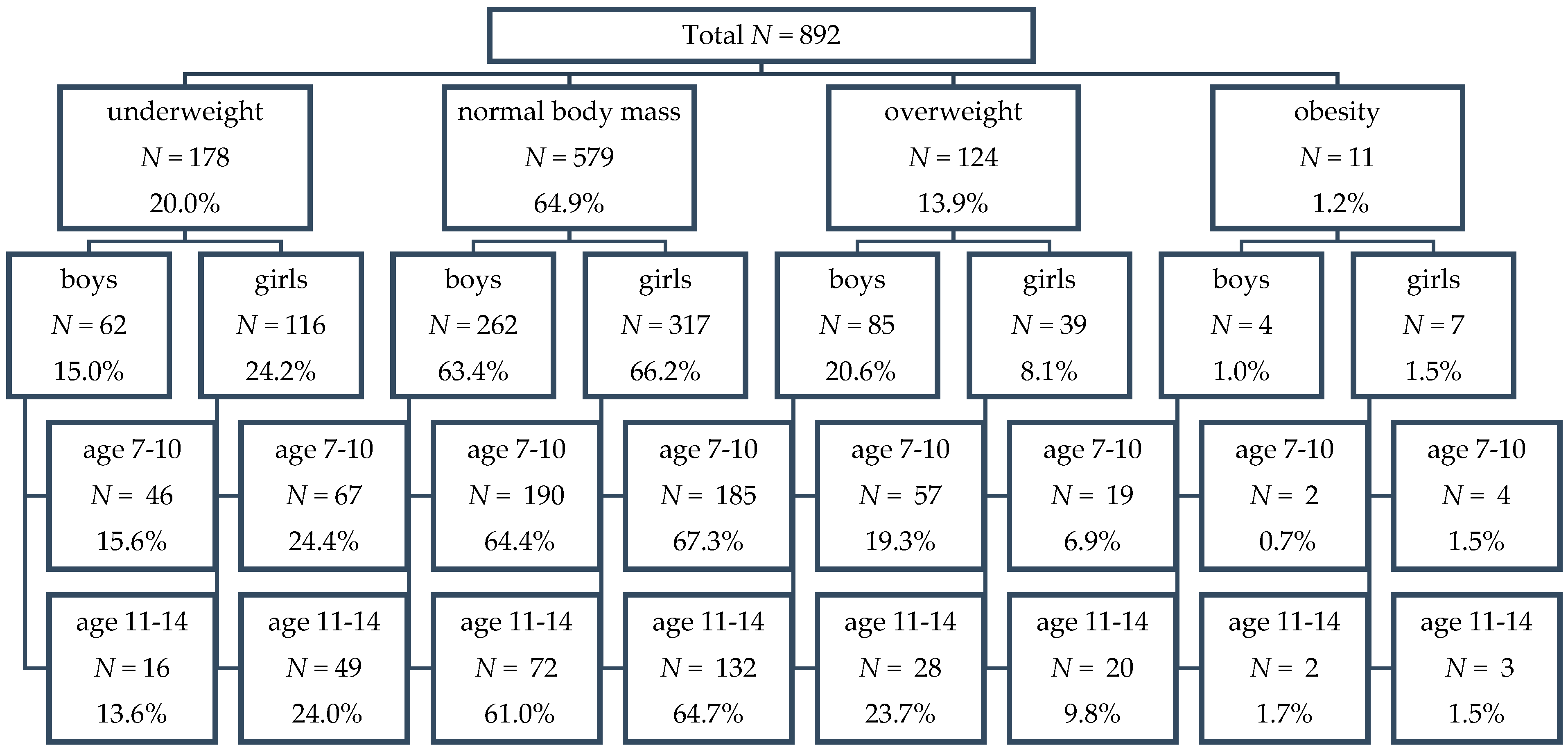
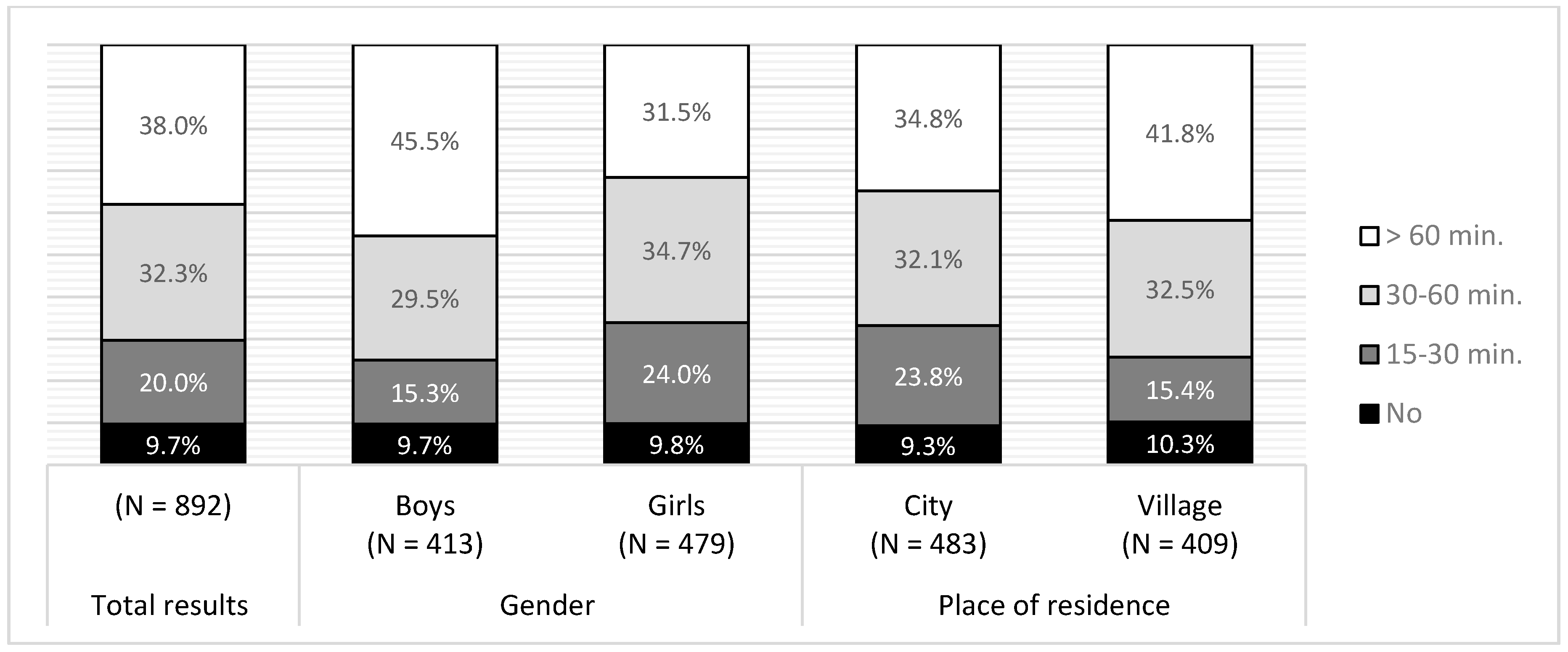
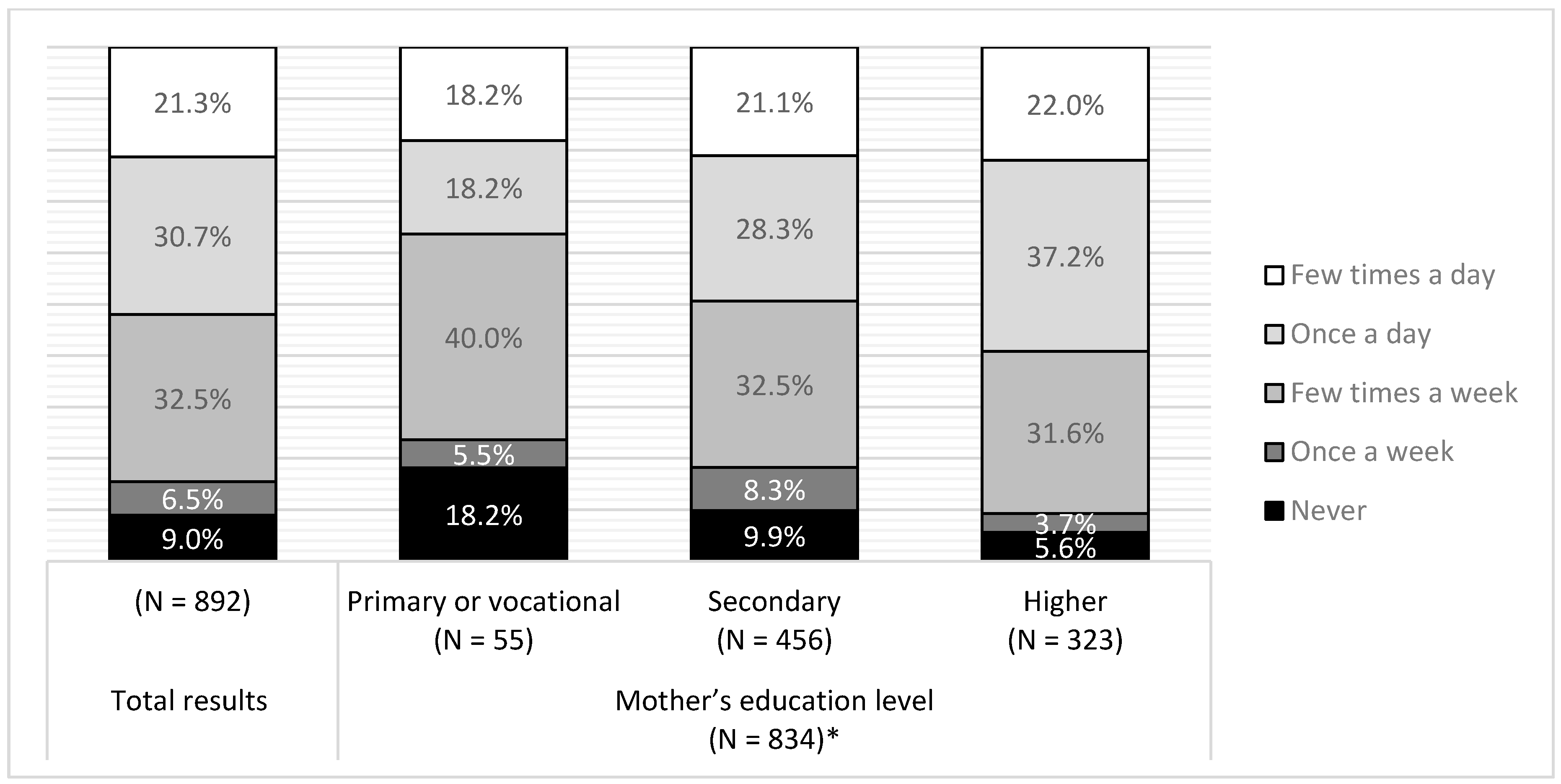
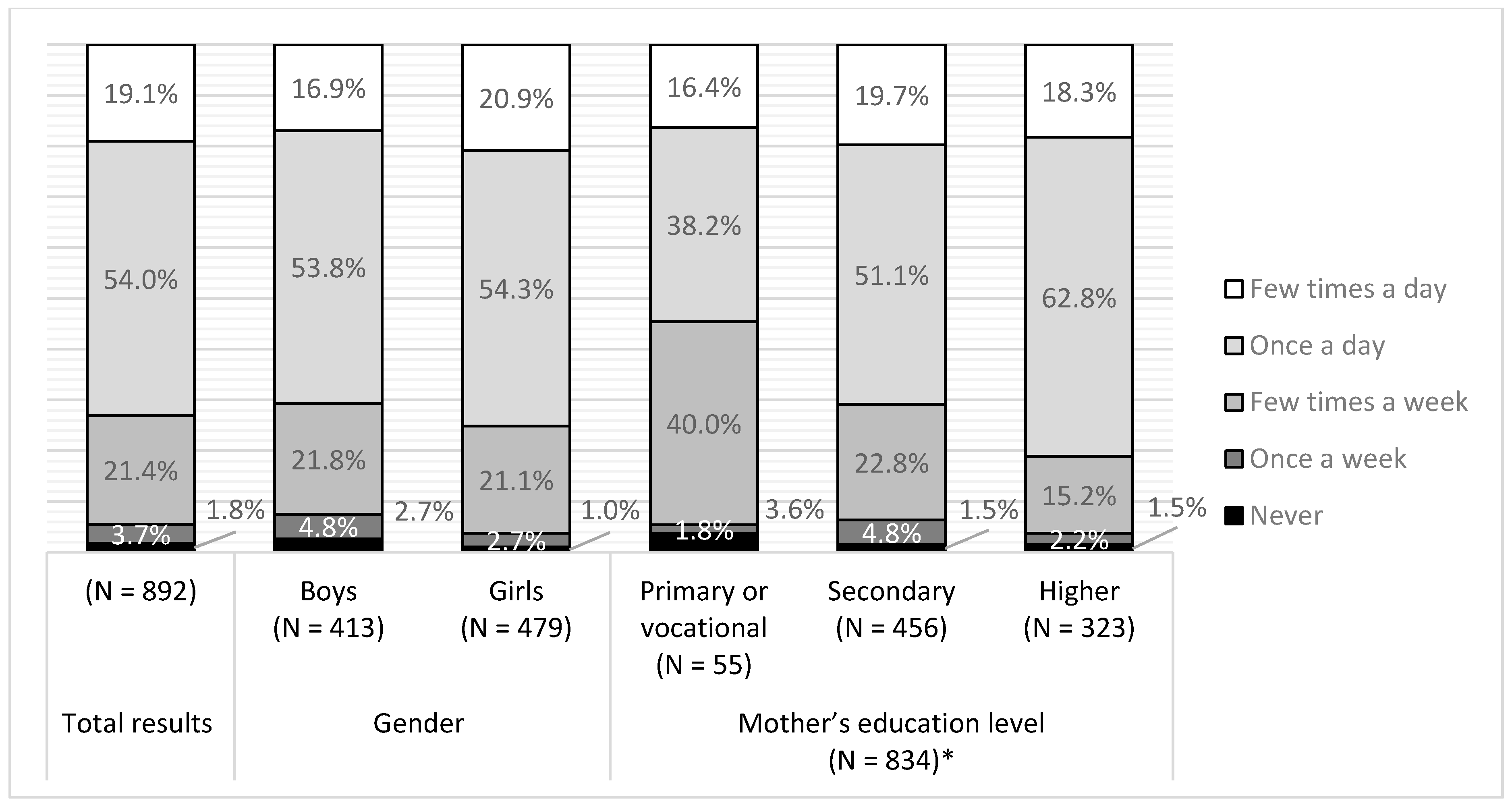
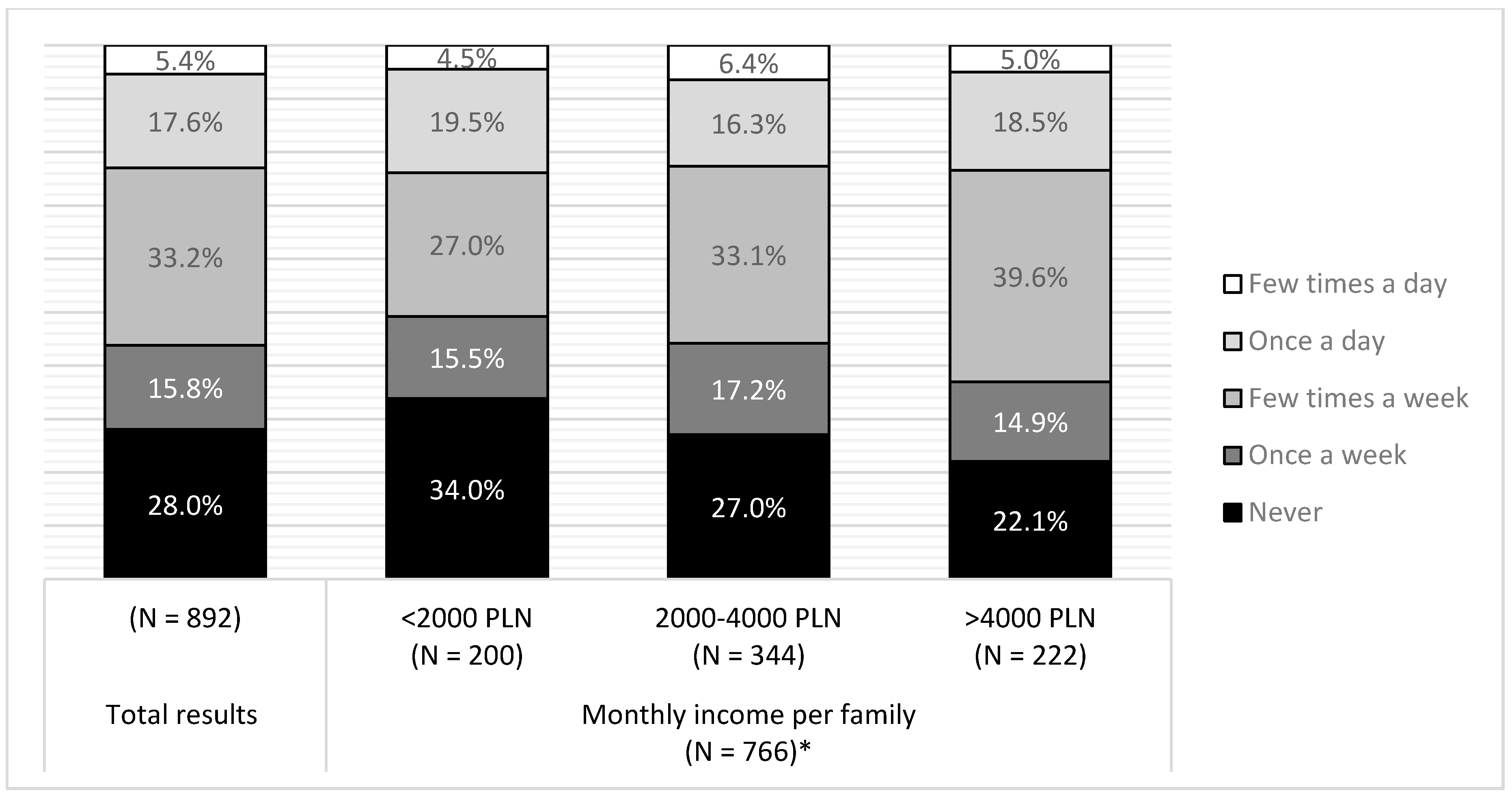
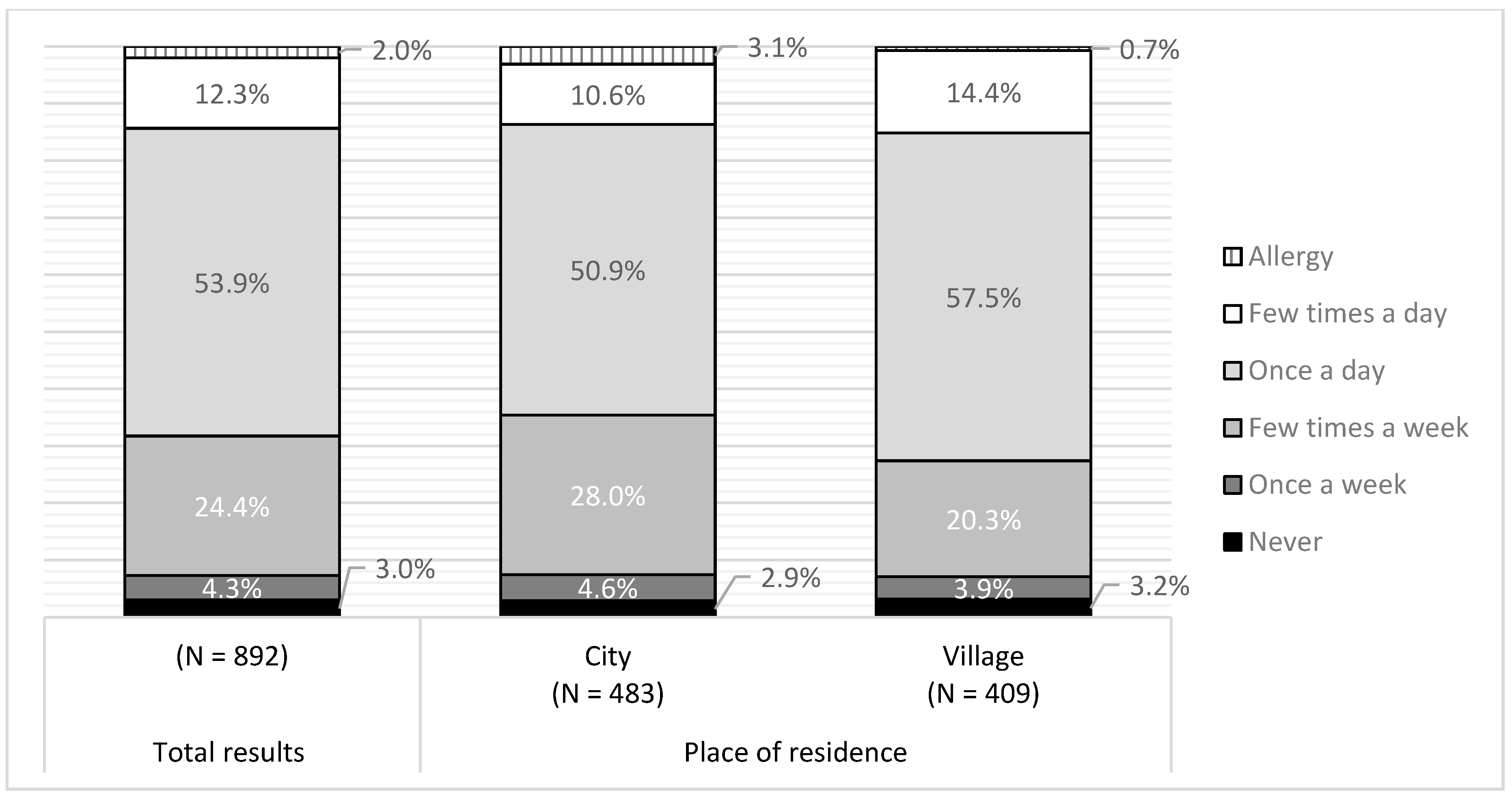
| Environmental Factors | N | % | |
|---|---|---|---|
| (1). Place of residence | City | 483 | 54.1 |
| Village | 409 | 45.9 | |
| (2). Mother’s education level | Basic and vocational education | 55 | 6.2 |
| Secondary education | 456 | 51.1 | |
| Higher education | 323 | 36.2 | |
| Not declared | 58 | 6.5 | |
| (3). Mother’s body mass (according to BMI) | Underweight | 34 | 3.8 |
| Normal body mass | 542 | 60.8 | |
| Overweight | 183 | 20.5 | |
| Obese | 45 | 5.0 | |
| Not declared | 88 | 9.9 | |
| (4). Net income per family * | <2000 PLN | 200 | 22.4 |
| 2000–4000 PLN | 344 | 38.6 | |
| >4000 PLN | 222 | 24.9 | |
| not declared | 126 | 14.1 | |
| (5). Number of children in the family | 1 | 196 | 22.0 |
| 2 | 471 | 52.8 | |
| 3 | 156 | 17.5 | |
| 4+ | 69 | 7.7 | |
© 2018 by the authors. Licensee MDPI, Basel, Switzerland. This article is an open access article distributed under the terms and conditions of the Creative Commons Attribution (CC BY) license (http://creativecommons.org/licenses/by/4.0/).
Share and Cite
Zadka, K.; Pałkowska-Goździk, E.; Rosołowska-Huszcz, D. Relation between Environmental Factors and Children’s Health Behaviors Contributing to the Occurrence of Diet-Related Diseases in Central Poland. Int. J. Environ. Res. Public Health 2019, 16, 52. https://doi.org/10.3390/ijerph16010052
Zadka K, Pałkowska-Goździk E, Rosołowska-Huszcz D. Relation between Environmental Factors and Children’s Health Behaviors Contributing to the Occurrence of Diet-Related Diseases in Central Poland. International Journal of Environmental Research and Public Health. 2019; 16(1):52. https://doi.org/10.3390/ijerph16010052
Chicago/Turabian StyleZadka, Katarzyna, Ewelina Pałkowska-Goździk, and Danuta Rosołowska-Huszcz. 2019. "Relation between Environmental Factors and Children’s Health Behaviors Contributing to the Occurrence of Diet-Related Diseases in Central Poland" International Journal of Environmental Research and Public Health 16, no. 1: 52. https://doi.org/10.3390/ijerph16010052
APA StyleZadka, K., Pałkowska-Goździk, E., & Rosołowska-Huszcz, D. (2019). Relation between Environmental Factors and Children’s Health Behaviors Contributing to the Occurrence of Diet-Related Diseases in Central Poland. International Journal of Environmental Research and Public Health, 16(1), 52. https://doi.org/10.3390/ijerph16010052





